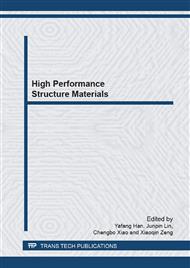[1]
D. Raable, Coputational Materials Science, Chemistry Industry, Beijing, (2002).
Google Scholar
[2]
Y. Mishin, A.Y. Lozovoi, Angular-dependent Atomic interchange Potential for Tantalum, Acta Mater. 54 (2006) 5013-5026.
DOI: 10.1016/j.actamat.2006.06.034
Google Scholar
[3]
Y. Chen, S. Iwata, T. Mohri, First-principles calculation of L10-disorder phase diagram in Fe-Pt system within the first and second nearest neighbor pair interaction energies, Calphad 26(4) (2002) 583-589.
DOI: 10.1016/s0364-5916(02)80010-4
Google Scholar
[4]
T. Mohri, Y. Chen, First-principles investigation of L10-disorder phase equilibria of Fe-Ni, -Pb, and –Pt binary alloy systems, J. Alloy. Compd. 383 (2004) 23-31.
DOI: 10.1016/j.jallcom.2004.04.030
Google Scholar
[5]
H.K. Kim, W.S. Jung, B.J. Lee, Modified embedded-atom method atomic interchange potentials for the Fe-Ti-C and Fe-Ti-N ternary systems, Acta Mater. 57 (2009) 3140-3147.
DOI: 10.1016/j.actamat.2009.03.019
Google Scholar
[6]
F. Fang, X.L. Shu, H.Q. Deng, et al., Modified analytic EAM potentials for the binary immiscible alloy systems, Mater. Sci. Eng. A 355 (2003) 357-367.
DOI: 10.1016/s0921-5093(03)00102-3
Google Scholar
[7]
A.G. Khachaturyan, Theory of Structural Transformation in Solids, Wiley, New York, (1983).
Google Scholar
[8]
C. Xu, Z. Chen, Y.L. Lu, et al., Inversion of the first nearest neighbor interchange interaction potential in L12 structure by Microscopic Phase-Field simulation, Rare Metal Mater. Eng. 39(6) (2010) 1027-1030. (in Chinese).
Google Scholar
[9]
C. Pareige, F. Soisson, G. Martin, et al., Ording and phase separation in Ni-Cr-Al: Monte Carlo simulations vs three-dimensional atom probe, Acta Mater. 47 (1999) 1889-1899.
DOI: 10.1016/s1359-6454(99)00054-3
Google Scholar
[10]
Y.L. Lu, Z. Chen, Y.S. Li, et al., Microscopic Phase-field simulation coupled with elastic strain energy for precipitation process of Ni-Cr-Al alloys with low Al content, Trans. Nonferrous Met. Soc. China 17 (2007) 64-71.
DOI: 10.1016/s1003-6326(07)60049-1
Google Scholar
[11]
J.X. Zhang, Z. Chen, Q.B. Lai, et al., Microscopic Phase-field simulation of Re-ageing temperature on precipitation of Ni-Cr-Al alloys, Chinese J. Aeronaut. 22 (2009) 551-557.
DOI: 10.1016/s1000-9361(08)60140-5
Google Scholar
[12]
L.Q. Chen, A computer simulation technique for spinodal decomposition and ordering in ternary systems, Script. Metall. et Mater. 29 (1993) 683-688.
DOI: 10.1016/0956-716x(93)90419-s
Google Scholar
[13]
R. Poduri, L.Q. Chen, Computer simulation of atomic ordering and compositional clustering in the pseudobinary Ni3Al-Ni3V system, Acta Mater. 46(5) (1998) 1791-1729.
DOI: 10.1016/s1359-6454(97)00335-2
Google Scholar


